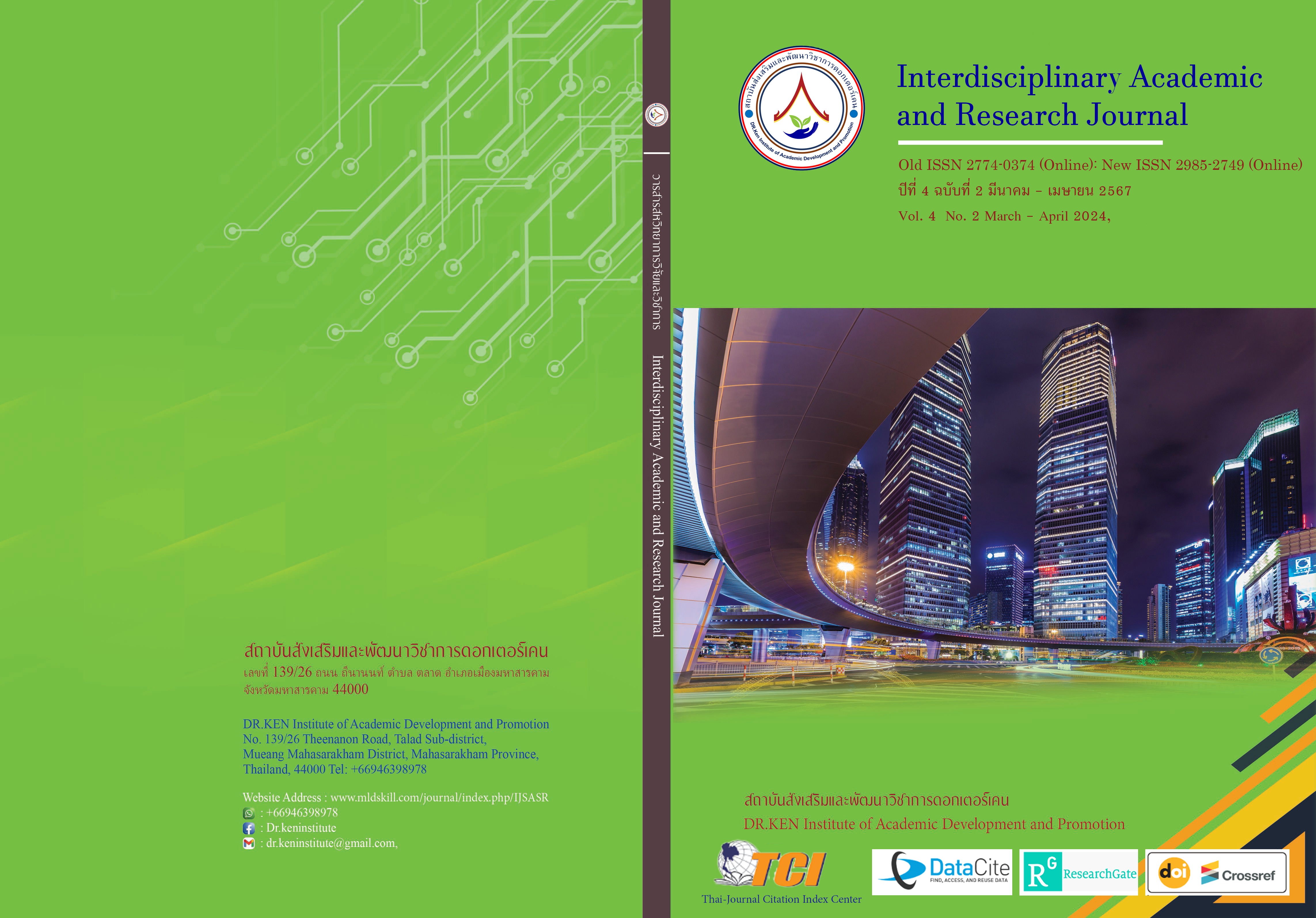Series of Archaeological Dances (RABAM PHIMAIPURA): The Performance Arises from Historical Locations and Creativity Has Benefits for the Phimai District in Nakhon Ratchasima Province
DOI:
https://doi.org/10.60027/iarj.2024.273632Keywords:
RABAM PHIMAIPURA;, Series of Archaeological Dances; , ValuesAbstract
Background and Aims: The RAMBAM PHIMAIPURA series of archaeology dances and performances spans more than three decades. The RAMBAM PHIMAIPURA plays an important role in Phimai District in terms of arts and culture, unity in human psychology, and other aspects. Nevertheless, neither the performance's provenance nor its worth can be determined with certainty from records or studies. The objectives of this research 2 are: 1) Examine the origins, composition, and history of the RAMBAM PHIMAIPURA or Series of Archaeological Dances. 2) Examine the worth of the Phimai District in the Series of RAMBAM PHIMAIPURA or Series of Archaeological Dances.
Methodology: Qualitative research that begins with gathering information from documentaries, research, and fieldwork Then summarize, analyze, and present the research results in the form of a descriptive analysis.
Results: 1) The RAMBAM PHIMAIPURA is an archaeological dance invented in 1988. The goal of Ms. Wanee Amatiratana's performances is to highlight regional features. The creative process of performance research and collecting both physical and abstract information is the first step in the performance development process. The dance has to be processed and designed in a second step. 2) The Phimai District benefits from RAMBAM PHIMAIPURA in five areas: academic, social and cultural, spiritual, belief, and economic.
Conclusion: Information about Phimai Historical Park and the artist's motivation is the foundation of the archaeological dance series (RABAM PHIMAIPURA). Furthermore, the Phimai District benefits from the performance.
References
จุติกา โกศลเหมมณี. (2556). รูปแบบและแนวความคิดในการสร้างสรรค์งานนาฏยศิลป์ไทยร่วมสมัย ของนราพงษ์ จรัสศรี. ศิลปศาสตรดุษฎีบัณฑิต, จุฬาลงกรณ์มหาวิทยาลัย.
นพพล จำเริญทอง. (2565). การสร้างสรรค์การแสดงนาฏศิลป์ระบำโบราณคดีของกรมศิลปากร. วารสารดนตรีและการแสดง. 7(2), 132-148.
นราพงษ์ จรัสศรี. (2556). รูปแบบและแนวความคิดในการสร้างสรรค์งานนาฏยศิลป์ไทยร่วมสมัย ของนราพงษ์ จรัสศรี (สัมภาษณ์). หัวหน้าภาควิชานากศิลป์ไทย คณะศิลปกรรมศาสตร์ จุฬาลงกรณ์ มหาวิทยาลัย. 10 เมษยายน 2556
พรเทพ บุญจันทร์เพ็ชร์. (2558). ประวัตินาฏศิลป์ไทย ภาคตะวันออกเฉียงเหนือ. กรุงเทพฯ: โอเดียนสโตร์.
พัชรินทร์ สันติอัชวรรณ. (2565). สุนทรียภาพในระบําโบราณคดี. วารสารจันทรเกษมสาร. 24(46), 17-29.
ภาณุวัฒน์ เอื้อสามาลย. (2566). อัตลักษณ์ทับหลังปราสาทพิมาย สู่ศิลปะสกุลช่างพิมาย. ในการสัมมนาทางวิชาการเรื่อง โครงการเสวนาวิชาการงานเทศกาลเที่ยวพิมาย ประจำปี 2566. (น. 4). นครราชสีมา: ม.ป.พ.
วรรณี อมัติรัตนะ. (2566), การแสดงระบำพิมายปุระ (สัมภาษณ์). ผู้สร้างสรรค์การแสดงระบำพิมายปุระ. 9 พฤศจิกายน 2566.
วลัยลักษณ์ ทรงศิริ. (2564). พิมายดำ : การเปลี่ยนแปลงสู่สังคมยุคเหล็กในอนุทวีปอินเดียสู่การรับ ปรับ และส่งต่อ สืบทอดในท้องถิ่นอันห่างไกล. Retrieved on 10 November 2023 from: http://https://walailaksongsiri.com/2021/04/09/phimai-black/.
ศิราพร ณ ถลาง. (2557). ทฤษฎีคติชนวิทยา : วิธีวิทยาในการวิเคราะห์ตำนาน-นิทานพื้นบ้าน. พิมพ์ครั้งที่ 3. กรุงเทพฯ: สำนักพิมพ์แห่งจุฬาลงกรณ์มหาวิทยาลัย.
ศิราพร ณ ถลาง. (2562). "คติชนสร้างสรรค์" บทวิเคราะห์และทฤษฏี. พิมพ์ครั้งที่ 2. กรุงเทพฯ: ศูนย์มานุษยวิทยาสิรินธร (องค์การมหาชน).
สุรพล วิรุฬห์รักษ์. (2547). หลักการแสดงนาฏยศิลป์ปริทรรศน์. กรุงเทพฯ: สำนักพิมพ์แห่งจุฬาลงกรณ์มหาวิทยาลัย.
สุริยวุฒิ สุขสวัสดิ์,หม่อมราชวงศ์. (2537). ศิลปะร่วมแบบเขมรในประเทศไทย: ภูมิหลังทางปัญญา-รูปแบบทาง ศิลปกรรม. กรุงเทพฯ: มติชน.
อโนทัย ส้มออ่ำ . (2563). คุณค่าของระบําลีลาลายสังคโลกที่มีต่อสังคมและวัฒนธรรม. วารสารวิชาการมหาวิทยาลัยการจัดการและเทคโนโลยีอีสเทิร์น. 17(1), 11-19.
อารยะ มนูญศักดิ์. (2561). การวิจัยสร้างสรรค์ผลงานจิตรกรรม เรื่อง ดินสาระความงามปราสาทหินพิมาย. NRRU Community Research Journal. 12(3), 104-113
Bascom, W. (1954). Four functions of folklore. The Journal of American Folklore. 67(266), 333-349.
Downloads
Published
How to Cite
Issue
Section
License
Copyright (c) 2024 Interdisciplinary Academic and Research Journal

This work is licensed under a Creative Commons Attribution-NonCommercial-NoDerivatives 4.0 International License.
Copyright on any article in the Interdisciplinary Academic and Research Journal is retained by the author(s) under the under the Creative Commons Attribution-NonCommercial-NoDerivatives 4.0 International License. Permission to use text, content, images, etc. of publication. Any user to read, download, copy, distribute, print, search, or link to the full texts of articles, crawl them for indexing, pass them as data to software, or use them for any other lawful purpose. But do not use it for commercial use or with the intent to benefit any business.
















.png)


